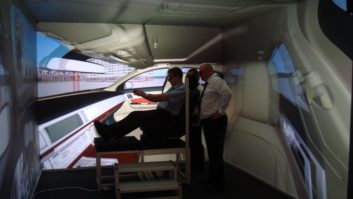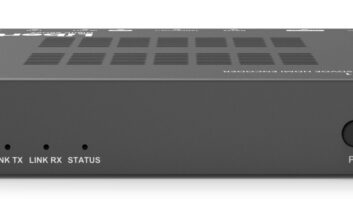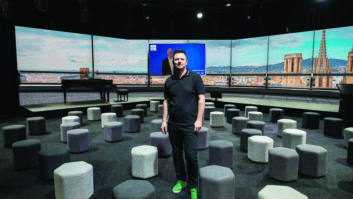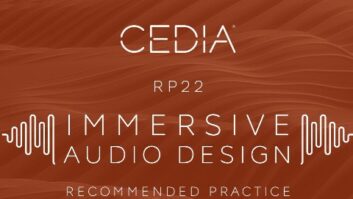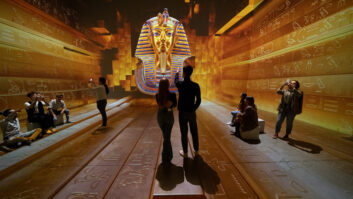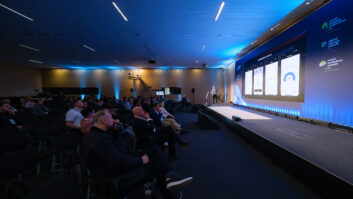Industry headlines over the past few months have confirmed the current buzz around all things immersive audio. Barco announced the acquisition of 3D sound pioneer IOSONO in late September in a move that is set to further strengthen its track record in immersive audio for cinema. Meanwhile, in the residential space, Dolby has announced that Paramount Pictures and Warner Bros movies featuring Dolby Atmos soundtracks are to be made available for home theatre enthusiasts with Dolby Atmos-enabled AV receivers and speakers, via Blu-ray and streaming service VUDU.
Of course, ‘conventional’ surround sound is already a default for many cinemas and exhibitions; but immersive audio promises to quite literally add another dimension – height – as the advent of enhanced channel-based and object-oriented technologies relieve public audio of its traditional restrictions.
Dolby Atmos adopts an object-oriented approach to audio as opposed to a channel-centric one. For filmmakers, this means that “any sound heard in a film scene is an audio object, for example a helicopter taking off or a child crying”, explains Jonathan Jowitt, evangelist content and e-media solutions, Dolby Laboratories. “With Dolby Atmos, you have amazing flexibility: the format provides even richer, more detailed sound by rendering to overhead or height speakers and/or to more than seven speakers at the listener level,” he says.
Also making waves in the immersive audio world is Auro Technologies’ Auro-3D. Auro claims to deliver ‘surround sound with height’ with this format, which embodies a hybrid approach. “Auro-3D is using both the channel- and object-based approach,” says Auro Technologies’ CEO, Wilfried Van Baelen, “but in a different way than our competitors, in order to first create the most natural immersive sound experience in a channel-based solution and then use object-based technology for interactivity and to further define more spot point sources in the hemisphere.”
Germany-based IOSONO Sound has undoubtedly proven to be one of the most influential forces in immersive audio – and its acquisition by Barco certainly won’t harm its global profile. The current IOSONO offer incorporates a ‘toolchain’ for production (Spatial Audio Workstation), distribution (IOSONO Container + Master Files) and reproduction (the IOSONO CORE hardware processor, which is described as the ‘heart’ of IOSONO’s 3D sound systems).
IOSONO, explains Barco senior director strategic business development entertainment Brian Claypool, is “designed for object-based audio [but will] support channel-based audio as well. Speaker layouts can be designed flexibly for a specific purpose and venue, [and] a full 360º system is possible.”
Datasat Digital Entertainment was formed in 1991 and began to attract widespread attention after its digital audio system was used during production of Jurassic Park. Originally engineered for 5.1 surround sound, Datasat Digital Sound technology has developed to improve the quality of surround sound to 7.1 and 11.1. Datasat recently announced a link-up with Dolby that will see the Datasat RS20i home cinema processor made available with
Dolby Atmos.
Focused firmly towards the museum, theatre and installed space in general, Out Board UK’s TiMax SoundHub is another animal again, providing source/speaker matrixing and spatialisation scaleable from 16×16 up to 64×64 sizes. Explaining TiMax SoundHub’s distinctive niche, Out Board director Dave Haydon explains: “Its unique delay-matrix function and object-based virtual pan objects allow it to enhance both existing conventional surround formats, such as 5.1/7.1, and also create dynamic spatialisation soundscapes entirely.” The system combines playback, 3D spatialisation, show control, sound system distribution and management in one box.
The greater availability and affordability of wireless audio will surely be a vital factor in determining how widespread immersive sound environments ultimately become. But with the Barco/IOSONO announcement indicating the beginning of convergence and consolidation in the marketplace, we can expect the commercial push for commercial and residential applications to become increasingly acute.
For now, with all these companies showing their wares at ISE 2015, there’s no better opportunity to compare and contrast them for yourself.
